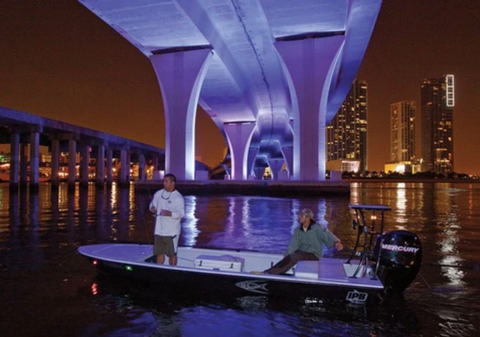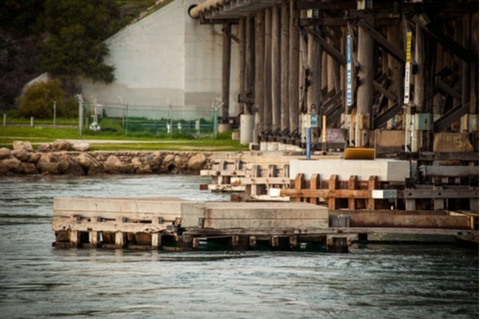
How to Fish Around Bridges For Sheepshead
Sheepshead Fishing Around Bridges Yields Big Convicts
If you polled 1000 sheepshead anglers where they love to fish for sheepshead, I am confident at least half would say around bridges. Bridges are found all over the inter-coastal waterway. If you have ever traveled down the waterway, chances are you passed under a couple of bridges. These bridges provide a food source for sheepshead. Chances are if you have ever pulled up on a bridge and looked down, you will have seen sheepshead swimming around feeding.
Many anglers blow by these areas without even thinking to stop and fish them. We want to give a guide for how to fish your local bridges safely and effectively. By following our guide and finding the sheepshead, I am confident you can fill a cooler full of sheepshead.
Bridges are made from all different materials, and the construction varies from region to region. Old bridges were made with wood pylons that would be crafted into the seafloor. These bridges did not last forever, and often the remnants can be seen around new bridges. The new construction of bridges consists mainly of poured reinforced concrete. These hold up better and can withstand the trials and tribulations that mother nature throws at it. These bridge construction methods are very different in components, yet you fish them the same way. There are three areas that all sheepshead fishermen should target when fishing bridges. This includes bridge pylons, divided bridge pylons, and channel bumpers. These areas will grow barnacles, house crabs, and small bait fish. This is the perfect equation for sheepshead and other inshore species of fish like black drum, redfish, trout, and flounder.
1) Bridge Fishing For Sheepshead: Bridge Pilings

Bridge Fishing Pylons For Sheepshead (Photo Credit: Sports Fishing Mag)
When fishing bridge pylons, there are a few things that anglers must be conscious to ensure safety and catch fish effectively. Safety should be your number one priority. Maintaining a healthy distance from the pylon itself is crucial to give you a direct area to fish and protect your watercraft from sustaining damage. Knowing your tide is helpful for fishing bridge pylons. During certain times of the day, these pylons will fluctuate with exposure due to the tides. When oysters or barnacles are exposed this could limit the feeding options of sheepshead. With the tide comes currents. Fishing these pylons when currents are working in certain directions can be easier. Knowing the direction of the current is crucial to floating your bait in the right spots. An important thing to remember is fish do not like swimming against the currents. When it comes to bridges, an Eddie will form on the opposite side; the current is flowing. Sheepshead will tend to feed in these areas. As an angler, you want to position yourself in the backside in these eddies to keep the boat from going with the current. If done correctly, you should be able to remain in Eddie without anchoring.
The depths at what you fish will vary with water depths and food sources on and near the pylons. The different species of inshore fish will be at different levels. Flounder will be at the bottom, trout will be from the middle to the top, and sheepshead could be at any level. The key to fishing it successfully is naturally presenting your bait.
There are a few different techniques I like to use around bridges when targeting sheepshead:
1) Sheepshead Jigs: Sheepshead jigs work best around pylons. It allows you to fish vertical and attract sheepshead at any depth. When using the sheepshead jig, it is best to tip it with a live fiddler crab. Drop it next to the pylon and allow it to sink to the bottom. Work it back up slowly in a jigging manner, and the sheepshead will not be able to resist. I have also topped my jigs with live shrimp, mussels, oysters, and other small crabs. When fishing, pylons use this technique, and you will find great success.
2) Free Line A Live Shrimp: If you are targeting sheepshead and just about any other species of fish, try free lining a live shrimp down the side of a pylon. I have caught some of my biggest sheepsheads this way. The natural fall of the shrimp will entice more than just sheepshead to bite. Keeping your bait on the line and away from everything else can be the challenge. The best hook that I like to use for this is a 1/0 or 2/0. I have known a lot of the sheepshead fisherman swear by the Owner 2/0. I only fish with a 2/0 Mustad Octopus hook when targeting sheepshead.
3) Artificial Crabs: Using artificial crabs is almost as good as the real thing. There are several companies on the market (Westin, Cranka, and Savage Gear) that make an artificial crab that looks as good or better than the real thing. I have fished with the Cranka crab for the last year and have had success with it. One thing that is hard when sheepshead fishing with artificial is how damaging they are to lures. They will rip legs and claws off as they try to eat it. The movement these crabs give off in the water mimicked the real thing. Adding a little scent like procure can take your artificial crabs to the next level.
2) Bridge Fishing For Sheepshead: Divided Bridge Pilings

Divided Bridge Pylons Perfect For Sheepshead Fishing (Photo Credit: Florida Sports Fishing)
The divides bridges offer an excellent escape from the current for predatory fish. Gaining access to this area can be a challenge sometimes. The larger the bridge, the bigger the pylons and space around them. If you can maneuver your boat in the area safely, you should clean up on the sheepshead. The hardest part will be fitting a larger boat in safely. Small johnboats and kayaks may be your only option on some divided bridge pylons. On some of the newly constructed bridges, the divided pylons can be a giant slab. This creates a giant sea wall in the middle of the water perfect for barnacle and oyster growth, creating a sheepshead paradise.
3) Bridge Fishing For Sheepshead: Channel Bumpers

Fishing Bridge Bumpers For Sheepshead (Photo Credit: FDOT.com)
This could be one of the harder areas to fish because bumpers will line the main channel, so stopping to fish may not be possible. You may have to attempt to fish the backside of them to be out of the way of incoming boat traffic. Fishing these areas in a kayak may be easier because of your ability to get close and stay out of the way. One reason that bumpers become such an excellent area for targeting sheepshead is that of their makeup. They are made up of a bunch of pilings that line the channel. Their function is to protect the bridge pylons from damage in case of a boating accident. They are usually long and have a good surface area to grow barnacles and attract bait and crabs. The sheer volume of pylons creates sheepshead heaven for food and will intimately attract them in. One thing to remember when fishing the channel bumpers, do not anchor in the channel. This is very dangerous and against the law.
Knowing how to successfully fish bridges is critical on your quest to catch sheepshead. Bridges provide the food sheepshead want. Once you know how to fish bridges and what to fish with, you will find yourself filling coolers with meat. If you have any questions, comments, or concerns, please feel free to leave us a comment below or email us at [email protected]. We would love to hear your near-record monster sheepshead experiences. We would also like to see all of your sheepsheads catches, so make sure you send us all your great catches to be featured on our social media pages. Make sure to check out our sheepshead Species page for more sheepshead blog content. We have an amazing sheepshead recipe for you after you limit out on sheepshead. Don't forget to get stocked with our sheepshead jigs at sheepshead nation for your next fishing trip. Get out there and fish around your bridges for sheepshead today.


Leave a comment